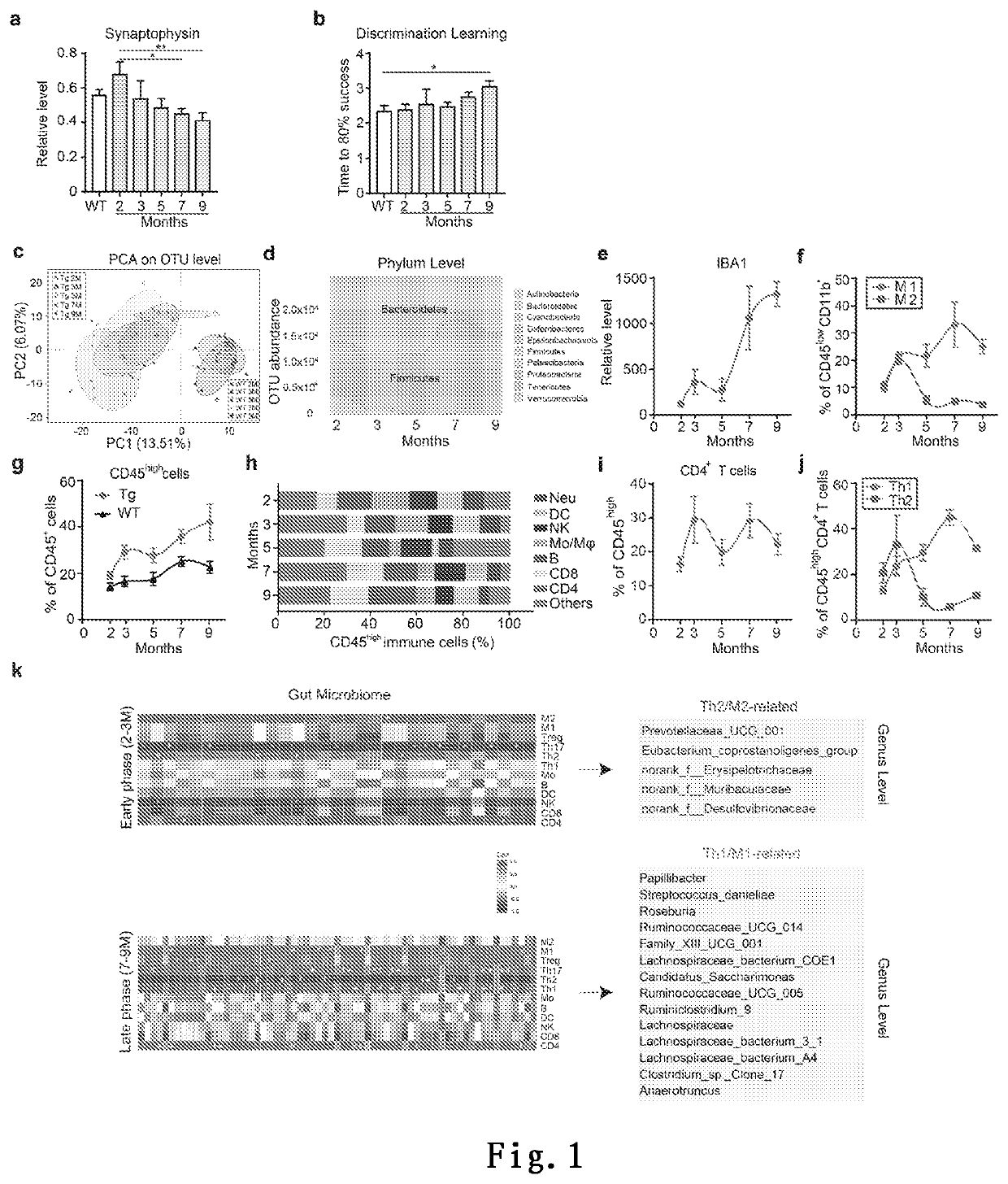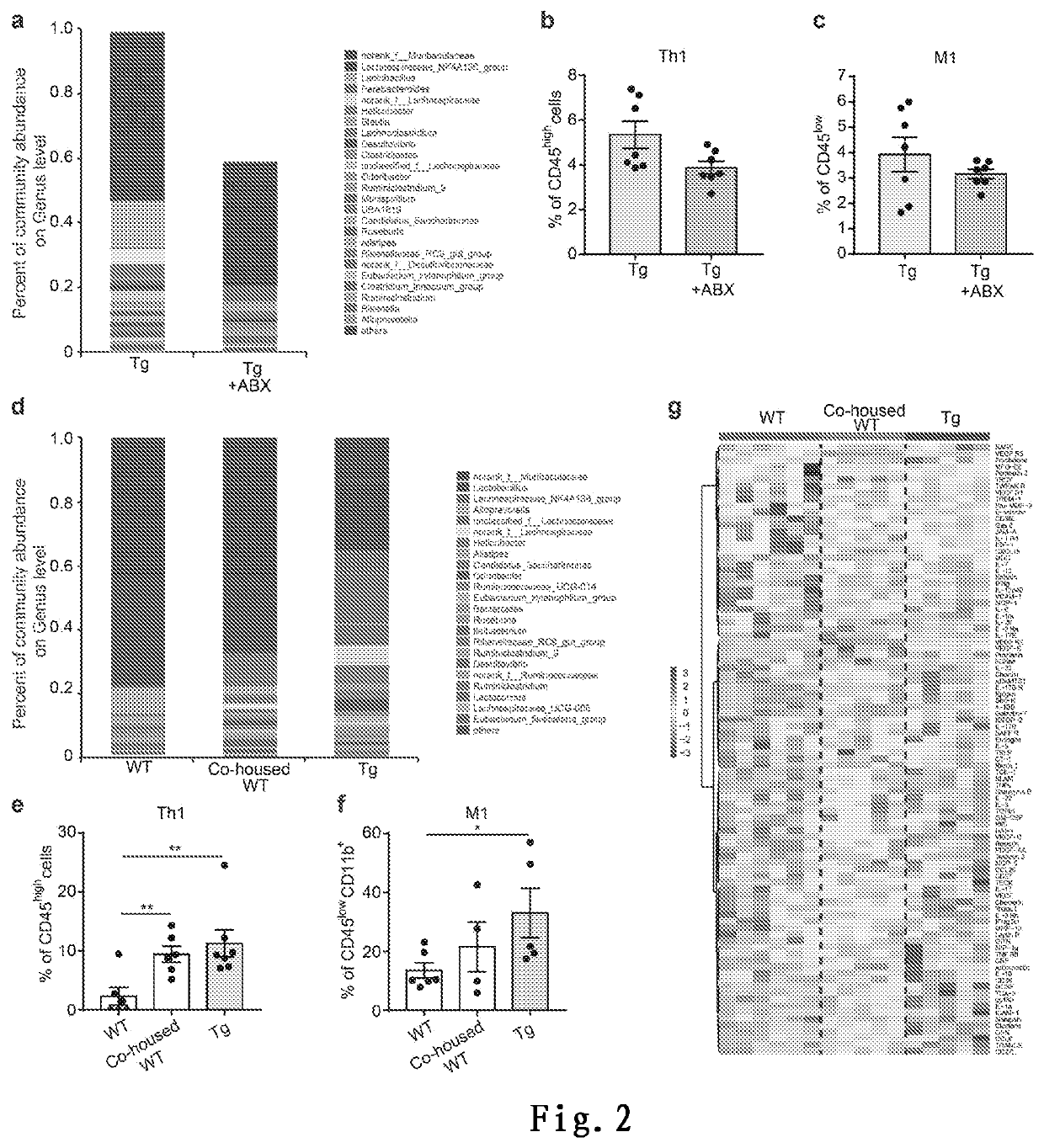Method for treating alzheimer's disease by regulating amino acid level
a technology of amino acid level and alzheimer's disease, applied in the field of treatment of alzheimer's disease, can solve the problems of severe atrophy in the damaged area of the brain, loss of synapses and neurons, etc., and achieve reliable and consistent cognitive improvement, promote the proliferation and differentiation of peripheral pro-inflammatory-types, and enhance neuroinflammation
- Summary
- Abstract
- Description
- Claims
- Application Information
AI Technical Summary
Benefits of technology
Problems solved by technology
Method used
Image
Examples
example
Materials and Methods
[0269]Animals
[0270]Tg mice and co-housed WT mice (corresponding WT mice generated by mating Tg mice and C57 mice) were housed in the same cage after birth. WT mice (C57) were housed in separate cages to avoid cross-transfer of microbiota. All mice were kept in a 23° C. room with a 12-hour (h) light-dark cycle. Mice were randomly assigned to different groups before treatment. For time course analysis of Tg mice, male and female Tg mice were sacrificed at 2, 3, 5, 7 and 9 months of age. The mouse brain was collected and stained for immune cell analysis and cytokine analysis. Before the mice were sacrificed, feces were collected for gut microbiota analysis. For OM1 treatment, at the age of 6.5 months, based on 450 mg b.i.d. (twice a day) in the phase III trial, Tg mice were treated with 100 mg / kg OM1 by oral administration once a day for one month. Behavioral tests were performed to monitor cognitive activity after the last treatment. The brains and feces of the mi...
example 1
ssion is Associated with the Alteration of Gut Microbiota and Immune Cell Infiltration
[0322]To assess the role of gut microbiota alteration in AD pathogenesis, the inventors used the 5XFAD transgenic (Tg) mouse model, which is widely used in AD study for its rapid onset and faithfully recapitulating multiple AD-associated pathological features and clinical phenotypes. It exhibits memory impairment in the 4th postnatal month, behavioural changes in the 7th month and loss of neurons in the 9th month. Age-matched wild-type (WT) mice from the same strain raised under the same conditions were used as controls. Consistent with previous reports, the inventors observed changes in Aβ plaque deposition, Tau phosphorylation, synaptophysin expression, behavior and the like. Specifically, Aβ plaque deposition in the cortex and hippocampus are rapidly accumulated beginning from the 3rd postnatal month (FIG. 7a). Tau phosphorylation in the brain of Tg mice was first found in the 5th month and incr...
example 2
n the Gut Microbiota Lead to Excessive Infiltration of Th1 Cells and Excessive Activation of M1 Microglia in the Brain
[0330]To determine whether the gut microbiota change is required for driving peripheral immune cell infiltration and in turn neuroinflammation in AD progression, the inventors used an antibiotic cocktail containing ampicillin (0.1 mg / mL), streptomycin (0.5 mg / mL), and colistin (0.1 mg / mL) in Tg mice at late stage (7 months of age) to ablate gut microbiota. Antibiotic treatment in Tg mice at late stage (7 months of age) resulted in a marked reduction in both microbial diversity and abundance in the gut (FIG. 2a).
[0331]Along with this change, the inventors observed a reduction in both infiltrating pro-inflammatory Th1 cells (FIG. 2b) and M1 cells (FIG. 2c) in the brain. This preliminarily proves that by interfering with the distribution of gut microbes in AD mice, the dominant state of Th1 and M1 in late-stage AD mice can be changed, indicating a causal relationship be...
PUM
| Property | Measurement | Unit |
|---|---|---|
| average molecular weight | aaaaa | aaaaa |
| confidence threshold | aaaaa | aaaaa |
| temperature | aaaaa | aaaaa |
Abstract
Description
Claims
Application Information
 Login to View More
Login to View More - R&D
- Intellectual Property
- Life Sciences
- Materials
- Tech Scout
- Unparalleled Data Quality
- Higher Quality Content
- 60% Fewer Hallucinations
Browse by: Latest US Patents, China's latest patents, Technical Efficacy Thesaurus, Application Domain, Technology Topic, Popular Technical Reports.
© 2025 PatSnap. All rights reserved.Legal|Privacy policy|Modern Slavery Act Transparency Statement|Sitemap|About US| Contact US: help@patsnap.com



